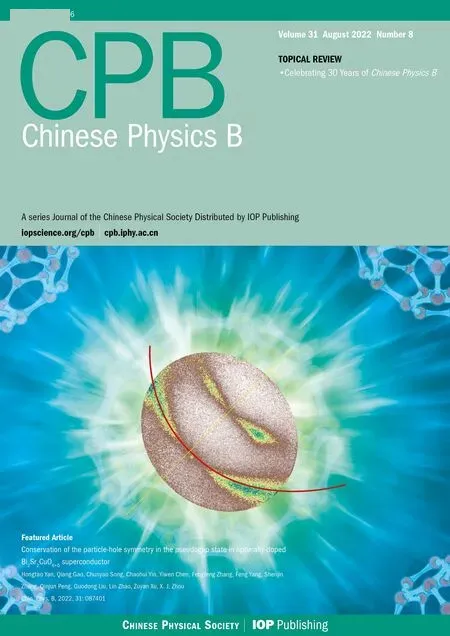A 45-µJ,10-kHz,burst-mode picosecond optical parametric oscillator synchronously pumped at a second harmonic cavity
2022-08-31ChaoMa马超KeLiu刘可YongBo薄勇ZhiMinWang王志敏DaFuCui崔大复andQinJunPeng彭钦军
Chao Ma(马超) Ke Liu(刘可) Yong Bo(薄勇) Zhi-Min Wang(王志敏)Da-Fu Cui(崔大复) and Qin-Jun Peng(彭钦军)
1Key Laboratory of Solid-State Lasers,Technical Institute of Physics and Chemistry,Chinese Academy of Sciences,Beijing 100190,China
2Key Laboratory of Functional Crystal and Laser Technology,Technical Institute of Physics and Chemistry,Chinese Academy of Sciences,Beijing 100190,China
3Institute of Optical Physics and Engineering Technology,Qilu Zhongke,Jinan 250000,China
4University of Chinese Academy of Sciences,Beijing 100190,China
Keywords: ultrafast laser,synchronously pumped optical parametric oscillator,high energy
1. Introduction
High-energy ultrafast laser sources in different spectral regions demonstrate a wide range of applications in stimulated Raman scattering (SRS),[1]spectroscopy,[2]high harmonic generation (HHG),[3]laser remote sensing,[4]and coherent anti-Stokes Raman scattering (CARS).[5]Synchronously pumped optical parametric oscillator (SPOPO) presents advantages of high parametric light conversion efficiency, narrow spectral linewidth, high beam quality, and low pump power threshold. Therefore, this method can effectively to obtain ultrashort pulse parametric oscillations in femtosecond or picosecond range.[6,7]Notably,to achieve synchronous pumping, the length of the OPO oscillator was required to be precisely matched with the pump beam pulse repetition rate (PRR), ensuring that the two pulses are synchronized in time. Since the OPO cavity length cannot be extended indefinitely, many reports on ps SPOPO typically concentrate on the pump source with RPR of tens or hundreds of MHz, corresponding to the SPOPO cavity length of several meters, resulting in the pulse energy of parametric light only at the nano joule level.[8,9]For instance, a ps SPOPO based on CdSiP2was operated at a repetition rate of 80 MHz and a cavity length of∼3.77 m; however, the produced signal pulse energy was lower than 0.55 nJ.[8]Based on MgO:PPLN,a similar ps SPOPO produced maximum signal power of 2.4 W at 79.4 MHz;but,the pulse energy was only around 30 nJ.[9]
Using methods, such as imaging relays[10]and fiber coupling,[11]to increase the cavity length allows the SPOPO to operate at repetition rates of around 7 MHz and output pulse energies up to several hundreds of nanojoules. Alternative approaches for scaling up the pulse energy, include burst-mode pumping,[12]high-harmonic cavity,[13]and cavity dumping.[14]However, the pulse energy generated by these methods still fails to exceed a few microjoules. Recently,our research team demonstrated the use of a regenerative amplifier(RA)to achieve intracavity SPOPO.[15]It outputs a maximum pulse energy of up to 30.5 µJ at 1.5 µm with a pulse duration of 7 ps, and operate at 10 kHz. This was the breakthrough record-high pulse energy from a ps SPOPO. However, most aforementioned SPOPOs were pumped by 1 µm laser, providing spectrum regions in the near (>1 µm) and mid-infrared. In order to expand the spectral coverage, the green-pumped OPOs were performed,and widely tunable signal spanning from visble 600 nm to near-infrared 1000 nm can be achieved.[16]For example, in the ps range, a PPKTPSPOPO designed by a fan-out grating pumped by a ps 532-nm laser was reported. However the signal pulse energy was only 7.3 nJ.[17]In the femtosecond range, a 532-nm femtosecond fiber laser achieves synchronous pumping of OPO based on MgO:PPLN.Unfortunately,the signal pulse energy was lower than 1.0 nJ.[18]
In this letter, we propose a novel green pumped ps SPOPO concept with multi-tens of microjoule of burst energy at the tens of kHz. Here, an OPO was synchronously pumped internal in a second harmonic(SH)cavity, the green SH pulse was produced by a ps 1-µm laser. The primary idea of this scheme is to confine the pump beam in the SH cavity by changing the wavelength of the pump beam. The obstacle of strictly matching the length of the OPO oscillator with the repetition rate of the pump beam can be overcome with this method. Instead,synchronous pumping can be achieved simply by making the resonators of OPO and SH to have the same optical length. This scenario presents the advantage of realizing a low-repetition rate OPO without the need for a long cavity length to meet the condition of synchronicity. A lowrepetition rate OPO has the advantage that high pulse energies can be achieved which is beneficial for biology,medicine and HHG applications.In a proof-of principle experiment,a ps 10-kHz 1064-nm laser with a maximum pulse energy of 300 µJ was used as the fundamental pump source,a 15-mm LBO was employed for second harmonic generation (SHG) and a 30-mm LBO for OPO, providing a record high burst energy of 45 µJ at signal beam of 900 nm. So far, this study is the first report on multiple tens of microjoule energy ps SPOPO pumped by green,and lowest repetition rate for green pumped OPO in the ps regime.
2. Experimental setup
Figure 1 shows the diagram of the experimental setup for a synchronously pumping OPO in the SH cavity. It consists of a ps 1064-nm fundamental laser, an SH resonator and a signal single resonant (SSR) OPO placed in the SH resonator.The fundamental ps laser was a 1064-nm Nd:YVO4regenerative amplifier (RGA), providing 300-µJ pulse energy with a pulse width of 86 ps and operates at 10 kHz. A combination of half-wave plate(HWP1)and thin film polarizer(TFP)was utilized to control the pump energy. The pump laser was shaped using a lens(L)with a focal length of 400 mm,providing a beam radius of around 320µm. The shaped fundamental pump beam was coupled with the SH resonator through mirrors M1 and M2. The M1 and M2 plane mirrors were coated with an angle of 45◦highly reflective (HR) film at 1064 nm.A second HWP2 was used to control the beam polarization for optimum SH phase matching. The ps green radiation was obtained by SHG in a 15-mm long LBO-1 crystal under noncritical type-I phase matching(θ=90◦,ϕ=10◦)at a temperature of 50.7◦C. The LBO-1 crystal was placed in an oven with a temperature control accuracy of 0.1◦C. Crystal end faces were coated with antireflection(AR)for high transmission at 532 nm and 1064 nm(T>99.5%). The green beam generated was used as the pump source of the OPO. The SH resonator was a standing-wave cavity composed of three plane mirrors(i.e.,M3,M5,and M6)and one concave reflective mirrors M4.The surface of M3 was coated with 1064-nm AR and 532-nm HR films. The concave mirror M4 presents a radius of curvature of 500 mm, and its surface was coated with 1064-nm AR and 532-nm HR films. M5 was AR-coated for the signal at 900 nm,and HR at 532 nm. The surface of M6 was coated with HR film at 532 nm and 900 nm. The geometric length of the SH oscillator design was 453 mm.
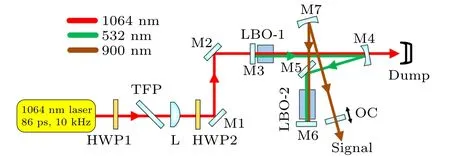
Fig. 1. Diagram of experimental setup for synchronously pumping OPO in SH resonator.
The SSR OPO was coupled into the SH resonator through the dichroic mirror M5. A type-I (θ=90◦,ϕ=0◦) LBO-2 crystal with size of 4 mm×4 mm×30 mm was used as the nonlinear crystal for the OPO and placed near M6.The LBO-2 crystal was mounted in a temperature-controlled oven, and the temperature was maintained within the range of 135◦C±0.2◦C.Both end faces of the crystal were coated with 532 nm and 900 nm to 1100-nm AR films.Both the green pump and OPO signal parametric pulses can pass through the LBO-2 crystal given that SH and OPO cavities contain common optical elements(i.e.,M5,LBO-2 crystal,and M6). The OPO was a V-shaped folded cavity composed of mirror M6,concave reflective mirror M7 and planar output coupler(OC).M7 exhibited a radius of curvature of 500 mm and was coated for high reflection at 900 nm. The OC had a transmittance of 28%at around 900 nm. The design of SH cavity with two internal foci results in a green SH beam radius of 0.22 mm in both LBO-1 as well as LBO-2 crystal. In order to obtain good mode matching between OPO signal and green SH beams in the LBO-2 crystal to improve the conversion efficiency in the process of frequency conversion. We designed the fundamental mode radius of the 900 nm signal in the LBO-2 crystal to be about 0.22 mm according to the ABCD matrix method.The distance between M6 and M7 was approximately 250 mm,the spacing between M7 and OC was 213 mm,and the total geometric length of the OPO oscillator design was 463 mm. Considering the difference of refractive index and physical length between the two crystals, the OC was placed on a precise translation stage to fine-tune the length of the OPO cavity for synchronous pumping conditions.
3. Experimental results
We first investigated the SHG pulse energy and the SH conversion efficiency before introducing the LBO-2 crystal and M6 in the cavity. Figure 2 shows the singlepass SH energy and efficiency as a function of the fundamental pump energy. The SH energy progressively increases with the increasing fundamental energy. A maximum SH output energy of 210µJ was obtained,and the corresponding conversion efficiency is up to 70%when the fundamental energy was 300µJ.
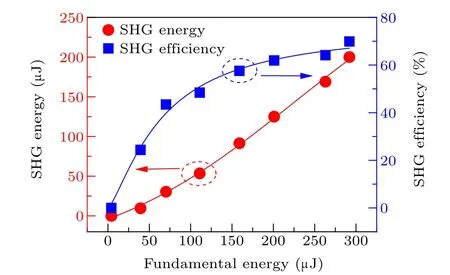
Fig.2. Dependence of the measured SHG energy and the corresponding conversion efficiency on the incident fundamental energy.

Fig.3. Pulse waveform of OPO signal: (a)pulse sequence of the OPO signal over a 1-ms time span and(b)expanded pulse profile.
When the LBO-2 crystal and M6 were inserted into the OPO cavity, the stable SPOPO operation was realized. The proposed scheme in this paper is different from the traditional synchronously pumped OPO. The green beam generated by the SHG will oscillate many times in the SH cavity, in the OPO process. Each time green beam pulse passes through the LBO-2 crystal, it will convert part of the energy to the OPO signal pulse and output part of the energy through OC until a single green beam pulse was exhausted. Based on the above process, the final output pulse of SPOPO operate in burst mode. The OPO signal pulse output from the OC was monitored with a photodetector(ALPHALAS GMBH,UPD-40-UVIR-P, rise time of<40 ps) and recorded using an 8-GHz digital oscilloscope (Agilent, DSO 80804B). The pulse train of the OPO signal over a 1-ms time span is shown in Fig. 3(a), which indicates that the OPO works at an RPR of 10 kHz. Figure 3(b)displays an expanded OPO pulse profiles.As shown in Fig. 3(b), the OPO operates in burst mode with six individual ps pulses with an approximate spacing of about 3 ns apart within the nanosecond envelope. The duration of each burst was about 15 ns. The repetition rate of the pulse trains in each burst was 324 MHz, which corresponds to the OPO cavity length. The pulse amplitude of the OPO signal in the envelope gradually increases,reaches a maximum value at the third pulse,and then gradually decreases.
Figure 4 shows the burst energy of the OPO signal as a function of the fundamental pump energy. As the incident pump energy increases,the output burst energy increases monotonically and no saturation effect was observed. The maximum output burst energy of the OPO signal was 45 µJ at a fixed temperature of 135◦C and a pump energy of 300µJ.The slope efficiency of the burst signal energy extracted from the pump beam was about∼16%. The photon conversion efficiency from 1-µm fundamental pump to 900-nm OPO signal beam was 12.7%, and the optical-to-optical conversion efficiency was 15%. It is found in Fig. 3(b) that the individual main pulse accounts for about 40% of the burst energy, corresponding the single pulse energy of about 18 µJ, which is more than three orders of magnitude higher than the optimal result obtained in a previous study.[19]
In the burst pulse, the pulse width of a single OPO signal pulse was measured by an autocorrelator. Figure 5 shows the normalized intensity autocorrelation trace of a single OPO signal pulse at full energy output. The pulse width of a single OPO signal pulse was estimated to be approximately 46.8 ps through Gaussian fitting. This value is significantly narrower than that of the pump pulse due to the time gain narrowing effect
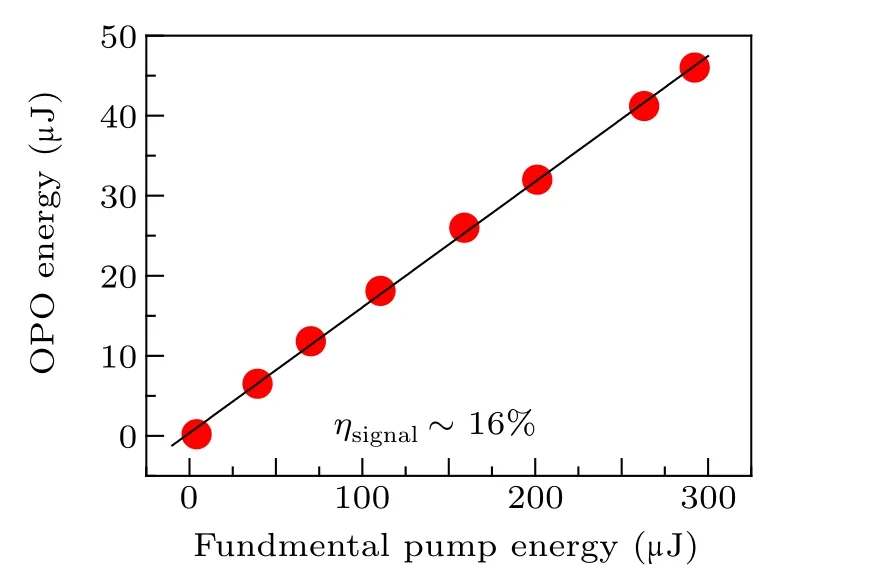
Fig. 4. Evolution of output signal burst energy with fundamental pump energy.

Fig.5.Measurement of the autocorrelation trace of a single OPO signal pulse and its Gaussian fit.
Using the spectrum analyzer (Ocean Optics,HR2000+CG UV-NIR, 1-nm resolution), we measured the wavelength of the signal beam of OPO from the beam leaked from mirror M7,as shown in Fig.6. It was found from Fig.6 that the central wavelength of the OPO signal beam is 900 nm.The illustration in Fig. 6 shows the detailed profile of the spectrum with a spectrum width of 1.09 nm.
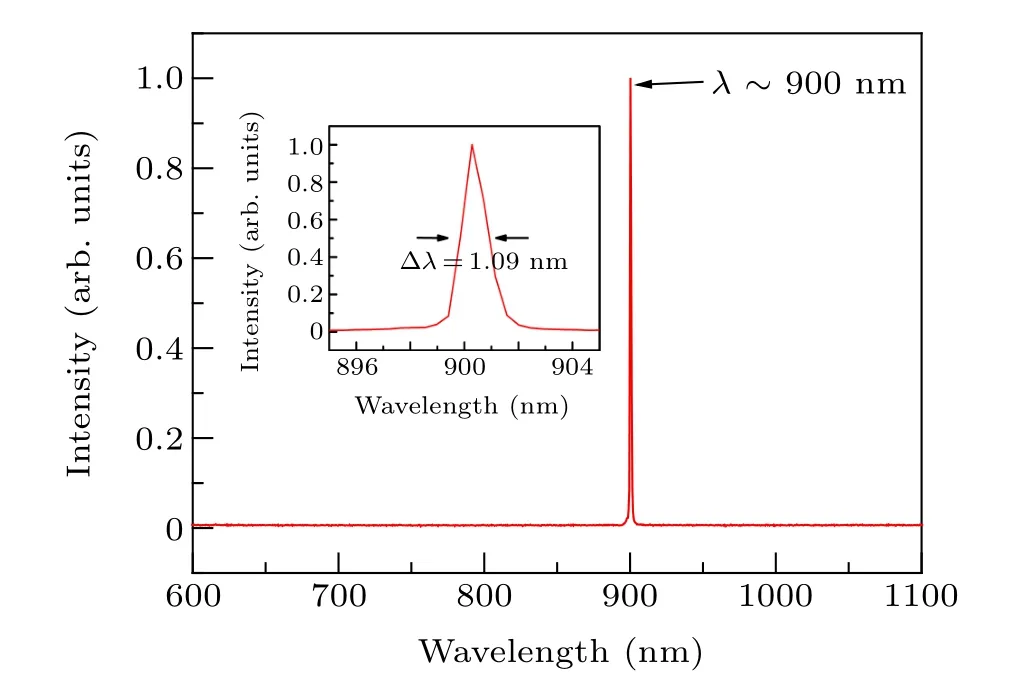
Fig.6. Measurement of the spectrum of the 900-nm signal beam generated by OPO.Illustration is shown in spectrum diagram in detail.
Using the beam analyzer (Spiricon M2-200s), we measured the beam quality of OPO signal beam. Figure 7 shows the beam quality of OPO with an output burst energy of 45µJ.The beam quality was measured asM2x=1.44 andM2y=1.40 in the orthogonal directions, and the corresponding average beam quality wasM2=1.42.The two-dimensional(2D)beam intensity distribution at the beam waist is shown in the inset of Fig.7, where it can be seen that the intensity is nearly Gaussian profile.
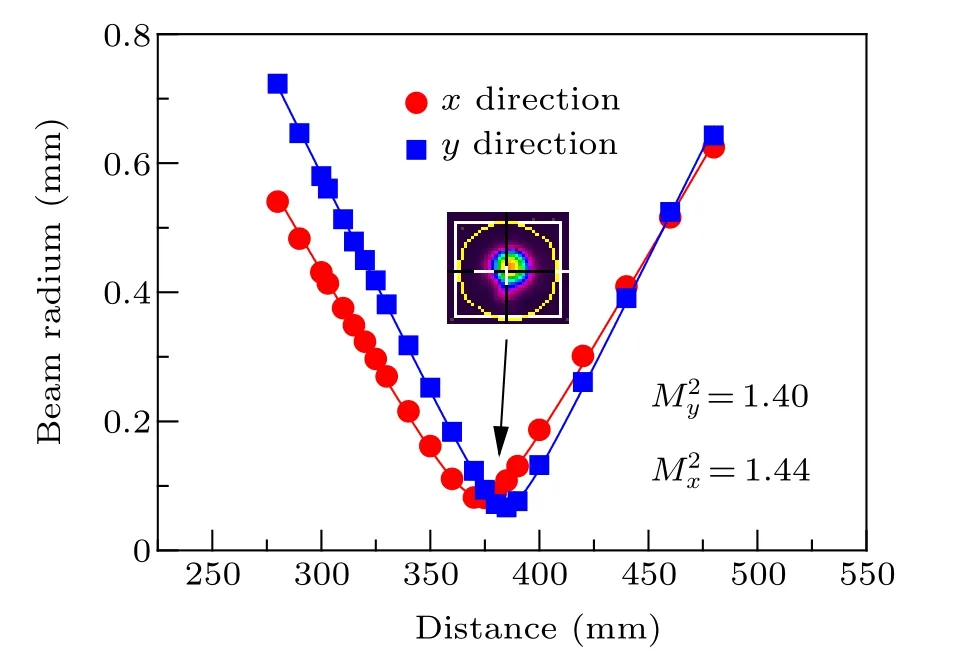
Fig. 7. Beam quality factor M2 of the 900-nm OPO signal beam measured under an output burst energy of 45µJ.Illustration shows the 2D beam intensity distribution.
The long-term energy stability of the SHG beam shown in Fig. 8(a) confirmed that the energy stability is better than 0.4% rms over 1 hour. Furthermore, we characterized the output stability of OPO by measuring long-term average energy fluctuations.Figure 8(b)shows the signal energy stability recorded over one hour. The signal exhibits energy stability better than 1.2% rms over 1 hour under free running conditions. However,compared with the green SH beam,the signal energy still exhibits three times larger fluctuation. The decrease in energy stability of the output signal was mainly due to the temperature fluctuation of the oven when operating OPO at a high temperature (∼135◦C) much higher than the laboratory temperature (∼28◦C). Temperature fluctuation will change the refractive index of the crystal, which makes OPO fluctuate around the phase matching state,resulting in unstable output energy.
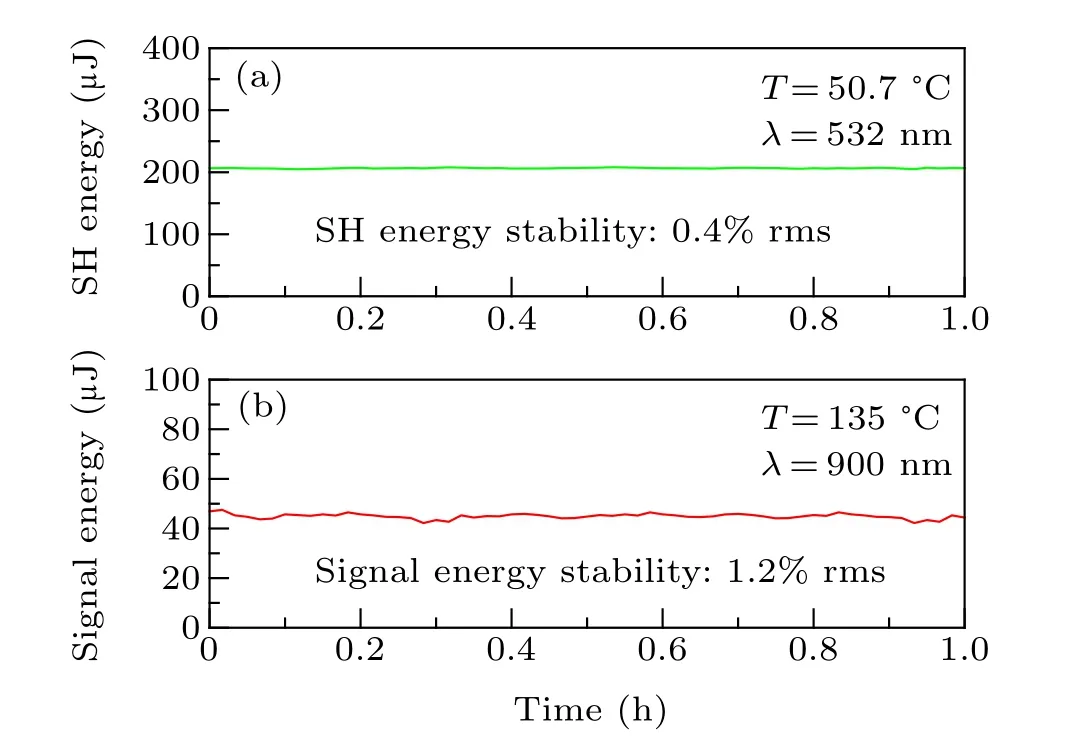
Fig.8. Energy stability of the(a)SHG and(b)signal beams.
4. Conclusion
In summary,we designed a novel method to realize high energy ps SPOPO in SH resonator. The proposed method can overcome the obstacle of strictly matching the length of the OPO cavity with the repetition rate of the pump beam. Under the pump energy of 300µJ,the maximum output burst energy of the OPO signal was 45 µJ at repetition rate of 10 kHz. In the burst pulse,the pulse duration of a single OPO signal pulse was measured to be approximately 46.8 ps at 900-nm signal.The beam quality was measured asM2x=1.44 andM2y=1.40 in the orthogonal directions.As far as we know,this study was the first report on multi-tens of microjoule energy ps SPOPO pumped by green,and lowest repetition rate for green pumped OPO in the ps regime,which is also the shortest cavity length in any ultrafast SPOPO.The experimental results showed that the proposed method can obtain higher energy ps pulses on a compact setup compared with the traditional synchronously pumped optical parametric oscillator. Moreover, the second harmonic generated by different fundamental frequencies can also realize the SPOPO in a wider spectrum range. We believe that further optimization of the OPO scheme can obtain highenergy ultrafast laser sources in different spectrum regions,which will play an important role in biology, medicine, and automobile fields.
Acknowledgment
Project supported by Youth Innovation Promotion Association,Chinese Academy of Sciences(CAS).
猜你喜欢
杂志排行
Chinese Physics B的其它文章
- Magnetic properties of oxides and silicon single crystals
- Non-universal Fermi polaron in quasi two-dimensional quantum gases
- Purification in entanglement distribution with deep quantum neural network
- New insight into the mechanism of DNA polymerase I revealed by single-molecule FRET studies of Klenow fragment
- A 4×4 metal-semiconductor-metal rectangular deep-ultraviolet detector array of Ga2O3 photoconductor with high photo response
- Wake-up effect in Hf0.4Zr0.6O2 ferroelectric thin-film capacitors under a cycling electric field
